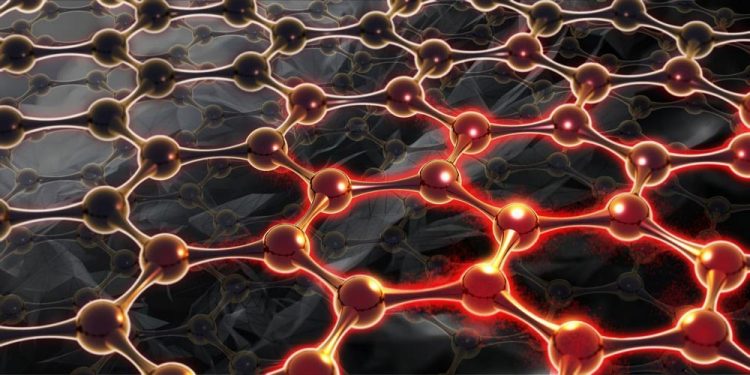Graphene assembled film shows higher thermal conductivity than graphite film

In the graphene film, phonons -- quantum particles that describe thermal conductivity -- can move faster in the graphene layers rather than interact between the layers, thereby leading to higher thermal conductivity. Credit: Chalmers University of Technology/Krantz Nanoart
Until now, scientists in the graphene research community have assumed that graphene assembled film cannot have higher thermal conductivity than graphite film. Single layer graphene has a thermal conductivity between 3500 and 5000 W/mK. If you put two graphene layers together, then it theoretically becomes graphite, as graphene is only one layer of graphite.
Today, graphite films, which are practically useful for heat dissipation and spreading in mobile phones and other power devices, have a thermal conductivity of up to 1950 W/mK. Therefore, the graphene-assembled film should not have higher thermal conductivity than this.
Research scientists at Chalmers University of Technology have recently changed this situation. They discovered that the thermal conductivity of graphene assembled film can reach up to 3200 W/mK, which is over 60 percent higher than the best graphite films.
Professor Johan Liu and his research team have done this through careful control of both grain size and the stacking orders of graphene layers. The high thermal conductivity is a result of large grain size, high flatness, and weak interlayer binding energy of the graphene layers. With these important features, phonons, whose movement and vibration determine the thermal performance, can move faster in the graphene layers rather than interact between the layers, thereby leading to higher thermal conductivity.
“This is indeed a great scientific break-through, and it can have a large impact on the transformation of the existing graphite film manufacturing industry”, says Johan Liu.
Furthermore, the researchers discovered that the graphene film has almost three times higher mechanical tensile strength than graphite film, reaching 70 MPa.
“With the advantages of ultra-high thermal conductivity, and thin, flexible, and robust structures, the developed graphene film shows great potential as a novel heat spreading material for thermal management of form-factor driven electronics and other high power-driven systems”, says Johan Liu.
As a consequence of never-ending miniaturisation and integration, the performance and reliability of modern electronic devices and many other high-power systems are greatly threatened by severe thermal dissipation issues.
“To address the problem, heat spreading materials must get better properties when it comes to thermal conductivity, thickness, flexibility and robustness, to match the complex and highly integrated nature of power systems”, says Johan Liu. “Commercially available thermal conductivity materials, like copper, aluminum, and artificial graphite film, will no longer meet and satisfy these demands.”
The IP of the high-quality manufacturing process for the graphene film belongs to SHT Smart High Tech AB, a spin-off company from Chalmers, which is going to focus on the commercialisation of the technology.
###
More about: The research
The work has been done in collaboration with research teams at Uppsala University and SHT Smart High Tech AB in Sweden, Shanghai and Tongji University in China and University of Colorado Boulder in USA.
The paper “Tailoring the Thermal and Mechanical Properties of Graphene Film by Structural Engineering” is published online in the well-known scientific journal Small: https:/
More about the graphene film:
The manufacturing method of the graphene film is based on simultaneous graphene oxide film formation and reduction, on aluminum substrate, dry-bubbling film separation, followed by high-temperature treatment as well as mechanical pressing. These conditions enable the formation of the graphene film with large grain size, good atomic alignment, thin-film structure, and low interlayer binding energy. All these features have great benefit for the transfer of both high-frequency diffusive phonons and low-frequency ballistic phonons, and thereby lead to the improvement of in-plane thermal conductivity of the graphene film. Phonons are quantum particles that describe the thermal conductivity of a material.
Media Contact
All latest news from the category: Materials Sciences
Materials management deals with the research, development, manufacturing and processing of raw and industrial materials. Key aspects here are biological and medical issues, which play an increasingly important role in this field.
innovations-report offers in-depth articles related to the development and application of materials and the structure and properties of new materials.
Newest articles

NASA: Mystery of life’s handedness deepens
The mystery of why life uses molecules with specific orientations has deepened with a NASA-funded discovery that RNA — a key molecule thought to have potentially held the instructions for…

What are the effects of historic lithium mining on water quality?
Study reveals low levels of common contaminants but high levels of other elements in waters associated with an abandoned lithium mine. Lithium ore and mining waste from a historic lithium…

Quantum-inspired design boosts efficiency of heat-to-electricity conversion
Rice engineers take unconventional route to improving thermophotovoltaic systems. Researchers at Rice University have found a new way to improve a key element of thermophotovoltaic (TPV) systems, which convert heat…



